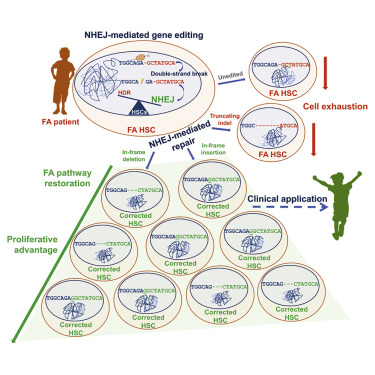Cell Stem Cell ( IF 19.8 ) Pub Date : 2019-09-19 , DOI: 10.1016/j.stem.2019.08.016 Francisco José Román-Rodríguez 1 , Laura Ugalde 1 , Lara Álvarez 1 , Begoña Díez 1 , María José Ramírez 2 , Cristina Risueño 1 , Marta Cortón 3 , Massimo Bogliolo 2 , Sara Bernal 4 , Francesca March 5 , Carmen Ayuso 3 , Helmut Hanenberg 6 , Julián Sevilla 7 , Sandra Rodríguez-Perales 8 , Raúl Torres-Ruiz 9 , Jordi Surrallés 2 , Juan Antonio Bueren 1 , Paula Río 1

|
Non-homologous end-joining (NHEJ) is the preferred mechanism used by hematopoietic stem cells (HSCs) to repair double-stranded DNA breaks and is particularly increased in cells deficient in the Fanconi anemia (FA) pathway. Here, we show feasible correction of compromised functional phenotypes in hematopoietic cells from multiple FA complementation groups, including FA-A, FA-C, FA-D1, and FA-D2. NHEJ-mediated repair of targeted CRISPR-Cas9-induced DNA breaks generated compensatory insertions and deletions that restore the coding frame of the mutated gene. NHEJ-mediated editing efficacy was initially verified in FA lymphoblastic cell lines and then in primary FA patient-derived CD34+ cells, which showed marked proliferative advantage and phenotypic correction both in vitro and after transplantation. Importantly, and in contrast to homologous directed repair, NHEJ efficiently targeted primitive human HSCs, indicating that NHEJ editing approaches may constitute a sound alternative for editing self-renewing human HSCs and consequently for treatment of FA and other monogenic diseases affecting the hematopoietic system.
中文翻译:

NHEJ介导的CRISPR-Cas9诱导的DNA断裂修复可有效纠正Fanconi贫血患者的HSPC中的突变。
非同源末端连接(NHEJ)是造血干细胞(HSC)修复双链DNA断裂的首选机制,在缺乏范可尼贫血(FA)途径的细胞中尤其明显。在这里,我们显示了来自多个FA互补组(包括FA-A,FA-C,FA-D1和FA-D2)的造血细胞中受损功能表型的可行校正。NHEJ介导的针对CRISPR-Cas9诱导的DNA断裂的修复产生了补偿性插入和缺失,可恢复突变基因的编码框架。NHEJ介导的编辑功效最初在FA淋巴细胞细胞系中得到验证,然后在原发于FA患者的原发性CD34 +细胞中得到验证,这两个化合物在体外均显示出明显的增殖优势和表型校正以及移植后。重要的是,与同源定向修复相反,NHEJ有效地靶向了原始人类HSC,这表明NHEJ编辑方法可能是编辑自我更新的人类HSC的合理选择,因此可用于治疗FA和影响造血系统的其他单基因疾病。











































 京公网安备 11010802027423号
京公网安备 11010802027423号